- keys "on 10", "at 17", "at 19"
- screwdrivers
- universal puller
Remove the generator from the car (see subsection 8.2.1.).

1. Turn away a nut and remove an adjusting lath.

2. Unscrew the fastening nut, holding the pulley from turning (see recommendation), and remove the pulley together with the fan impeller. Remove the key from the armature shaft.
Recommendation for surgery 2

The manufacturer recommends holding the pulley from turning with a special tool. If there is no device, you can do this:
1. Put the alternator belt on the pulley and on top of it - another belt of a larger section so as not to jam the pulley.
2. Clamp the pulley with belts in a vise and unscrew the fastening nut.
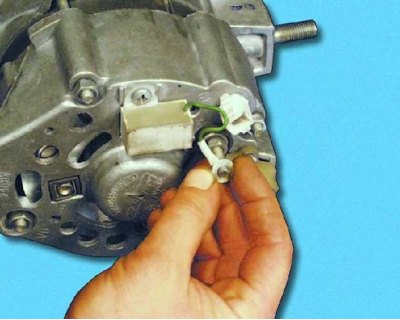
3. Loosen the nut and disconnect the capacitor wire from the terminal "30" generator.

4. Loosen the screw and remove the capacitor.

5. Disconnect the block with the wire from the brush holder.
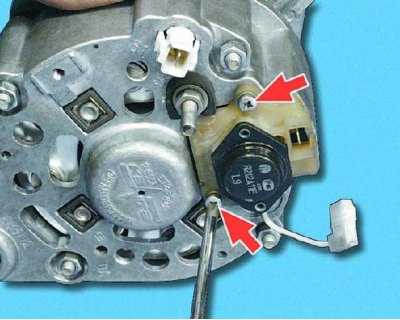
6. Loosen the two screws securing the brush holder.

7. Remove the brush holder with voltage regulator.

8. Loosen the four nuts and...

9....remove the four pinch bolts.

10. Using a puller, remove the drive side cover from the armature shaft.

11. Remove the spacer from the armature shaft.
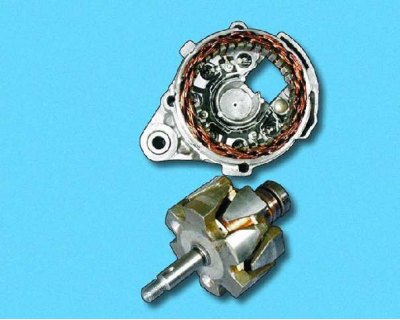
12. Remove the anchor from the cover on the manifold side.

13. Unscrew the three fastening nuts and disconnect the stator leads from the rectifier unit.

14. Remove the three bolts securing the rectifier unit and the stator leads with insulating pads.

15. Remove the stator from the cover.

16. Loosen the outlet fixing nut "30".

17. Press the protrusion on the plug inside the block with a screwdriver and push the plug with the wire inside the cover. In this case, the plastic block remains on the lid.
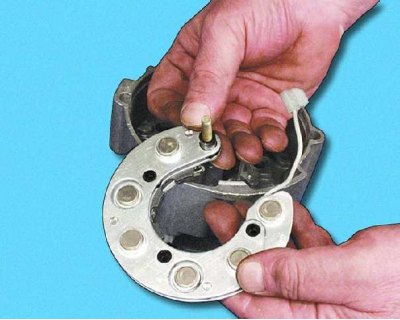
18. Remove the rectifier unit from the cover.
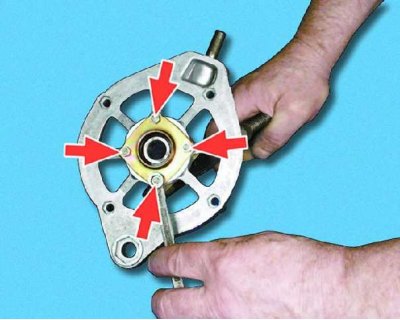
19. To replace the bearing in the cover on the drive side, unscrew the four fastening nuts, remove the bolts and...

20.... remove the inner and outer bearing mounting washers. Then, using a suitable mandrel, press the bearing out of the cover. Press the new bearing flush with the surface of the cover. The force must be applied only to the outer ring of the bearing.
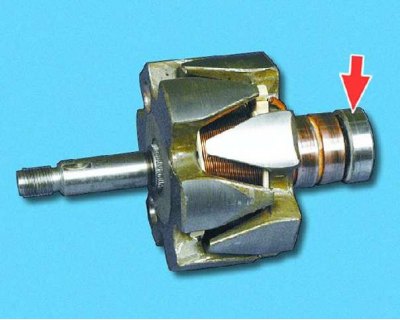
21. To replace the manifold side bearing, press it off the armature shaft with a puller. Press the new bearing in until it stops, applying pressure only to the inner race of the bearing.
Troubleshooting

Rectifier block: 1 - positive diodes; 2 - negative diodes; 3 - additional diodes

22. Check the voltage regulator. Connect a 12 V test lamp to the brushes. Apply 12V voltage: " " to the conclusion, and "–" on "mass" brush holder. The control lamp should light up.

23. Increase the voltage to 15-16 V - the lamp should go out. If the lamp does not go out or does not light up at 12 V, replace the regulator with brush holder.

24. Check the ease of movement of the brushes in the brush holder and their protrusion. If the brushes protrude from the brush holder by less than 5 mm, replace the voltage regulator with the brush holder. If chips or cracks are found on the brushes, replace the regulator.
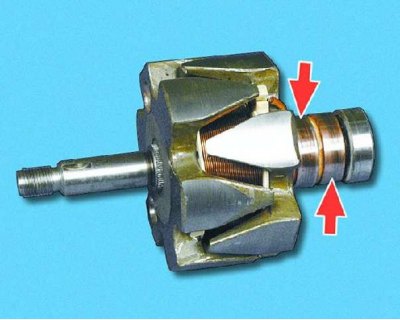
25. Inspect slip rings. If they have scuffs, marks, scratches, wear marks from brushes, etc., the rings must be ground. If damage to the rings cannot be removed with sandpaper, turn the rings on a lathe, removing the minimum layer of metal, and then sand.
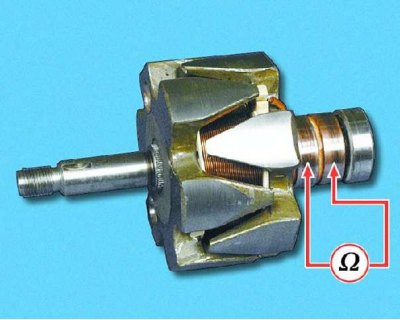
26. Check with an ohmmeter (tester) resistance of the rotor winding by connecting it to slip rings. If the ohmmeter shows "infinity", which means that there is a break in the windings and the rotor needs to be replaced.

27. Check with a test lamp if there is a winding short circuit to the rotor housing. Connect a control lamp to the storage battery. Connect one of the wires to the rotor housing, and the second - in turn to the rings. In both cases, the lamp should not light. If the lamp lights up, then the winding is closed: the rotor must be replaced.

28. Examine the stator. On the inner surface of the stator there should be no traces of armature touching the stator. If there is wear, the bearings or alternator covers must be replaced.

29. Check for an open in the stator winding. Connect a control lamp to the storage battery. Alternately connect a test lamp to the terminals of the winding. In all three cases, the lamp should be on. If the lamp does not light up, there is a break in the winding. Replace stator or winding.

30. Check if there is a short circuit in the stator windings to the housing. Connect a control lamp to the storage battery. Connect the lamp to the stator winding terminal, and the wire from the current source to the stator housing. If the lamp lights up, then there is a short circuit: it is necessary to replace the stator or winding.

31. Check the rectifier diodes with a 12V test light and battery. To test for shorts in the positive and negative diodes, connect " " batteries through the control lamp to the output "30" generator, and "–" batteries - to the generator housing. If the lamp lights up, then there is a short circuit in the diodes and the unit must be replaced (see recommendation).

Recommendation for operation 31. You can check the rectifier unit without removing the generator from the car. To do this, disconnect the wires from the battery and the generator, and also remove the block with the wire from the output of the voltage regulator.
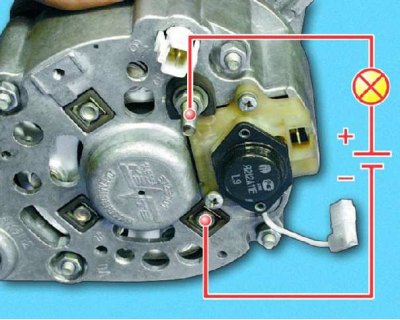
32. To test positive diodes, connect " " battery through the control lamp to the output "30" generator, and "–" battery - to one of the bolts securing the rectifier unit. If the lamp is on, then there is a short circuit in the positive diodes: the unit must be replaced.
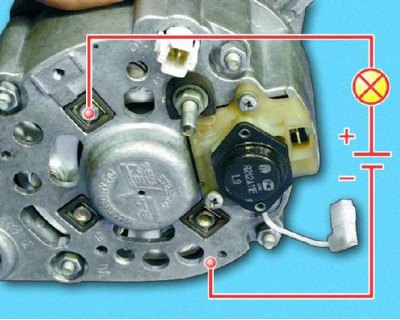
33. To test negative diodes, connect " " battery through a test lamp to one of the rectifier unit mounting bolts, and "–" battery - to the generator housing. If the lamp lights up, then there is a short circuit in the negative diodes: the unit must be replaced (see warning).
Warning for operation 33. A burning lamp when checking negative diodes may also indicate a short circuit in the stator winding to the generator case, however, such a malfunction is much less common than short circuit diodes.

34. To test additional diodes, connect " " battery through the control lamp to the output "61" generator, and "–" battery - to one of the bolts securing the rectifier unit. If the lamp lights up, then there is a short circuit in the additional diodes. The block needs to be replaced.
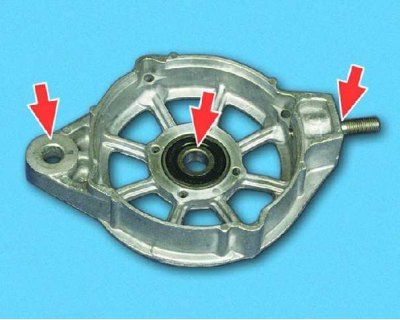
35. Inspect the generator cover from the drive side. If there are cracks, especially at the generator mounting points, replace the cover. Measure the diameter of the bearing seat in the drive end cap. If the bearing hole is deformed or its diameter exceeds 42 mm, replace the cap.

36. Check the ease of rotation of the bearings. If during rotation of the bearings there is play between the rings, rolling or jamming of the rolling elements, the bearings must be replaced. Also replace bearings with damaged protective rings or traces of grease leakage.

37. Inspect the generator cover from the side of the slip rings. If the bearing seat is damaged or worn, replace the cover.
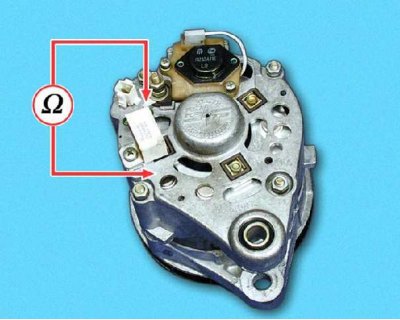
38. The health of the capacitor can be checked with a megger or tester (on a scale of 1–10 MΩ). Connect one tester probe to the capacitor terminal, and the second one to the generator case. Before connecting, the device shows "infinity". At the moment of connection, the resistance should decrease, and then return to its previous position: in this case, the capacitor is good. A defective capacitor must be replaced.

39. Assemble the generator in the reverse order of disassembly. Please note: the holes in the covers for mounting the generator must be aligned (according to the manufacturer, the misalignment should not exceed 0.4 mm). Tighten the alternator pulley nut to a torque of 39–90 N/m (3.9–9.0 kgf/m)
